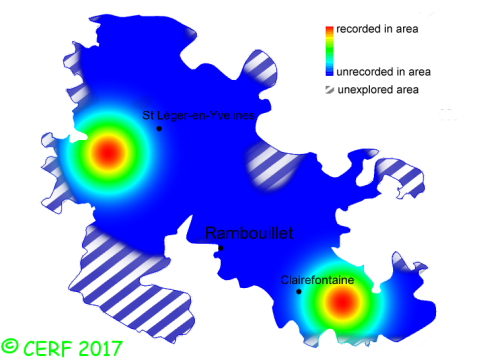|
Leccinum melaneum (Smotl.) Pilát & Dermek
|
New classification: Basidiomycota/Agaricomycotina/Agaricomycetes/Agaricomycetidae/Boletales/Boletaceae
Former classification: Basidiomycota/Homobasidiomycetes/Agaricomycetideae/Boletales/Boletaceae
(unconfirmed synonyms: Leccinum scabrum-melaneum)
edibility : edible
|
|
|
The cap is dark brown to black brown, matt, fleshy, initially firm then spongy, of hemispherical shape at the beginning, then convex to flat.
The cap surface is downy then smooth, matt if dry, slightly sticky in damp weather.
The stem is full, long and firm-tough, more or less equal or tapering at the top, rough, covered with blackish scales on a dark grey background, hard to distinguish from one another, especially towards the base..
The flesh is thick, firm at first then soon very soft, white or slightly yellowish below the skin, unchanging when exposed to air but sometimes turning pink a bit and very slowly in the upper half, however not turning green-blue in the stem base (whether inside or on the surface); its taste is faint or mild; the odour is faint;
The tubes are white to grey then ochre brown.
The pores are small, round, concolorous with tubes, turning brown/black when pressed (young) or unchanging.
The spore print is tobacco brown.
It grows in broad-leaved woods, with birch.
The fruiting period takes place from June to October.
| Dimensions: | width of cap approximately 9 cm (between 4 and 15 cm) |
| | height of stem approximately 10 cm (between 5 and 15 cm) |
| | thickness of stem (at largest section) approximately 30 mm (between 20 and 35 mm) |
| | spores : 15-20 x 5-7 microns, almost spindle-shaped |
Chemical tests : almost no reaction of flesh when in contact with formaldehyde; dark grey reaction when in contact to iron sulphate.
Distinctive features : Blackish cap; tough stem, covered with small black scales on a dark grey background; unchanging flesh, or turning very slowly pink when exposed to air, without any trave of grey-blue in the stem; with birch
Leccinum melaneum is rare and localised in the forest of Rambouillet, and is infrequent, more generally speaking
.
|  | | Above : distribution map of Leccinum melaneum in the forest of Rambouillet |
|
page updated on 14/01/18
